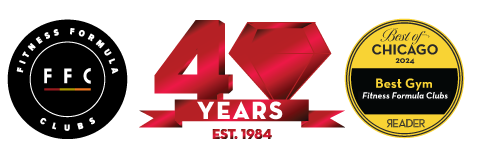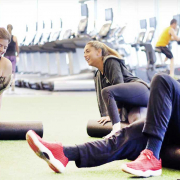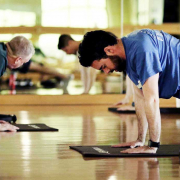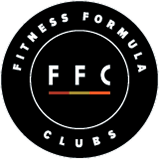Q&A with Massage Therapist Tony Ryan
Ah, the mysteries of getting older. While I think the process has a lot of perks, the gradual increase of aches and pains is definitely not one of them. Luckily, the growing trend of self-care has proven to be a great motivator in paying more attention to proper stretching, posture, muscle tension, flexibility, exercise, sleep and other factors.
Muscle tension, in particular, has become a big part of my focus as it relates to exercise and injury prevention. I have been paying more attention than ever before to what my body is telling me and actually seeking out semi-regular massage. I decided to do a Q&A with FFC massage therapist Tony Ryan, who focuses specifically on massage as it relates to muscular function. We discussed how massage helps with injury prevention and pain management (lookin’ at you, low back pain) and some takeaways that can help you feel better too.
So Tony, can you tell us a little bit about yourself and your background?
I’m a licensed massage therapist and am board-certified through the National Certification Board for Therapeutic Massage and Bodywork. I’ve been in the industry for a little over six years, and I focus mostly on anatomy, muscular function and making sure the body is in alignment with itself. A lot of times we tend to favor our dominant side until that gets hurt, then it tends to flip to the non-dominant side until that gets hurt. Everything works better if it’s in alignment. So the main goal is homeostasis through therapeutic work.
In your perspective, why do you think people might consider massage to be a frivolous expense or something to be saved for a special occasion?
It’s very much a Western mindset – massage being a luxury. I think it stems a little bit from societal norms and the medical industry – especially the societal issue of people not giving themselves enough care. We take care of our bodies probably the least of anything that we have in our lives. We get beat up constantly. And the rest of the world understands that if your body feels better, you’re going to be more efficient and productive. Whereas here in America, we try to put our heads down, barrel through and think that pain is okay and fine and normal, but it’s really not.
You’d mentioned the medical industry – can you elaborate?
People just want a pill that will cure them, but that won’t actually fix the problem. Whereas massage is work – it’s putting work into your body, and it’s work on your time outside of the massage room taking care of yourself as well. It’s a process, and that’s probably another deterrent for it. We want things now; we want to feel better now, nowadays. But that’s generally just not how the body works.
So talking a little bit about how massage does help – can you explain a little bit about how massage helps with injury prevention and neck/back pain, headaches, etc.?
Every single day we deal with stress. It’s unavoidable. Life is thrown at us – work, transportation – all of these things tend to hit certain areas of the body. The repetitive motions involved in our daily lives cause a lot of muscular tension. Once the muscles tighten into that contracted state, they start pulling the bones out of whack, which starts affecting the nerves, and then it all just goes downhill from there, and it becomes a lot more work to get it all back in place. So for instance, let’s say you’re leaning over a computer – it’s hitting that low back every single day. It’s going to start tensing up all those muscles, which pulls the hips out of whack, and once your hips are out of whack – that’s the foundation for the rest of your body, so everything starts falling out of whack.
This is what we put ourselves through every day. Massage helps us fight against that – in the low back, it helps ease up those muscles, makes sure the hips are in line, helps you see if one side is hitting worse than the other. Massage will help prevent the hips from pulling the bones out of whack and as a result, all of the other systems.
Okay, so that’s a little bit about preventative – what about injuries once you already have them?
Massage is definitely beneficial. It gets a bit trickier once there is an injury involved, and it depends on how long that injury has progressed. It might take a little more than a massage – massage is great when it comes to soft tissue, but obviously that’s only a small part of our bodies. Sometimes you might have to consider chiropractic methods or exercise. But at least we’re loosening up those muscles of the affected areas, helping the small supportive muscles play a larger role in that joint or muscle that is affected.
So when you are working with clients, what is the number-one ailment you encounter?
It does vary by person, but I would say a majority of my clients have neck and shoulder issues. Specifically shoulders that are rounded forward, which comes from the computer and desk work that most people do nowadays.
So in your mind, how often do you think people should get massages? Maybe a range – from most ideal frequency to the bare minimum?
It depends how much work is needed right off the bat. Generally to get a head start on things, I recommend people go every 2-3 weeks, but just for the first couple of times. My thought is that if I’m doing my job right, ideally you’re going to be coming in a little bit less. The massage will stick for longer, and we’ll be dealing with fewer issues in general. One massage a month is a good consistency that helps us stay ahead of the stress we deal with in a month. As I was saying before, that stress is unavoidable.
Related: Stressed? Here’s how massage therapy can help.
At a bare minimum, I would say quarterly, at least, so you can get those mental checks in: the awareness that you’re rounding your shoulders, or your one hip is off; you might be using your one leg too much – at least you can keep that in the back of your mind outside the massage room. You may not realize your body is out of whack; your brain is really good at turning off pain signals so that it’s not in pain all day. But pain is important because it tells us we need to get something fixed.
Wrapping up, do you have any other tips for injury recovery, prevention or maintenance you think could be a good takeaway?
The biggest thing is really listening to your body. Being body-aware is really, really important for injury prevention, especially with people who exercise. They might be doing an exercise and they’ll feel pain and say, ‘oh, that’s just me working out’ and push through and finish the set. But like I said, that pain is important because it’s your brain telling you, ‘hey, something is messed up right now’.
Stretching is a big one – at least a morning stretch to get your warmed up for the day, and a nightly stretch to ease away some of that stress from the day, before being stagnant for 6-8 hours while you’re sleeping and have that pain lock itself in there.
And finally, drink more water. That’s my biggest tip, always, to everyone. It might be hard to get used to at first, but your body does acclimate after a certain amount of time. To make sure you’re getting enough, I recommend getting a big water bottle (a half-gallon is a pretty good size) and then mark lines on it with times of the day when you should be finished. You can always play catch up if you need to, but it makes it a lot easier. It’s less taxing to think about it in time slots instead of certain numbers of glasses of water.
About Tony
Have low back or neck pain, curious about injury prevention or want to book an appointment? Email Tony at aryan@ffc.com to set up an appointment at FFC West Loop today.
Post written by FFC Contributor Megan Zink.









